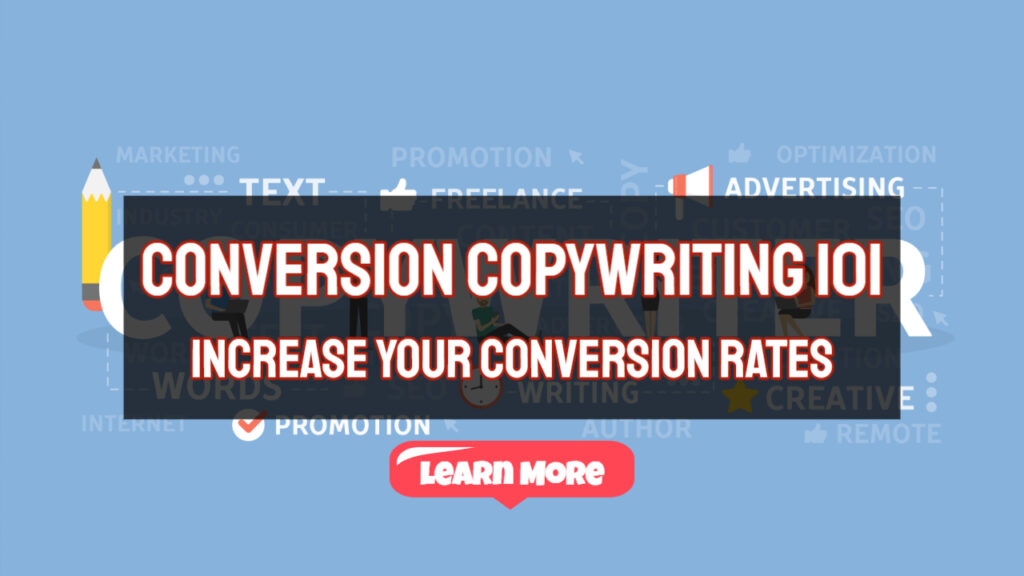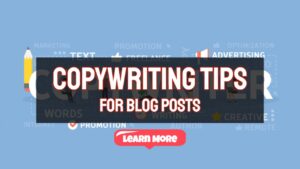Conversion Copywriting 101
How to Use Copywriting To Increase Your Conversion Rates: Whether you're a website administrator, marketing, or web developer, understanding how to increase the number of people who visit your website and, ideally, convert into customers is crucial. Conversion copywriting is one of the most effective ways to do this.
What is Conversion Copywriting?
Conversion copywriting is the process of crafting text that encourages your readers to take action, such as purchasing your products or services.
Copywriting allows you to appeal to the reader's emotions by precisely outlining how a product will affect the reader's life if they purchase it.
Your success as a copywriter is contingent on creating compelling material that attracts and persuades your target audience to purchase or learn more about a product or service. You may describe a measurable action that a reader will do after reading your information, which is known as a conversion.
In this piece, we'll go through how you can employ conversion copywriting abilities to boost website conversions.
Identify Your Reader’s Pain Points
People typically buy goods because they are driven by a strong desire to meet a need or solve a problem.
Great copy highlights and amplifies the customer's key aim, increasing their desire to buy.
This is often performed by identifying an issue or pain point and explaining how the solution will meet those criteria while simultaneously resolving the problem/pain point.
People are more likely to buy a product or service if you address their issues and provide a solution in the form of an offer.
In the form of Search Queries, Google Analytics, for example, can show you what your visitors are looking for on search engines.
These questions generate important keywords that help you learn what your website visitors are looking for the most.
Understanding your reader's misery enables you to focus on that anguish in order to captivate their attention and encourage them to do the action you wish.
Creating a Compelling Offer
As copywriters, we typically focus on expressing to the customer the benefits of a product or service. However, it's equally important to assess what you're offering and how you package it.
This level requires you to answer the following questions:
- What do you have?
- What will it do for them?
As a copywriter, your role is to demonstrate why your offer is better than the other alternatives accessible to your audience.
The first step in crafting a compelling offer is to make a promise to the reader [1]. Your promise should clarify how your product will assist customers in resolving their problems.
Following the presentation of a promise, the next process is to construct a value proposition that fulfills the audience's needs. Your value proposition should include the characteristics of your goods as well as how they benefit the reader.
The final step in creating a compelling offer is to deliver value that your reader will find tough to turn down. Value is perceived, and it may take the form of a discount or a bonus worth more than the reader is willing to spend.
Create Your Audience Persona
Knowing who you're attempting to persuade is critical for creating material that appeals to the proper type of prospective customers.
A persona is a false portrayal of your ideal customer. Knowing this “person” enables you to compose material that suits their specific needs, preferences, wants, and desires.
By developing the persona of your target consumer, you can create an appropriate copy bridge that takes them to the solutions or benefits that your items provide.
Client personas assist you in understanding [2] where your target client is in the purchasing cycle and how to effectively create a relevant message for them.
Learn and Understand AIDA
AIDA [3] is a framework for writing content that successfully interacts with your reader.
It refers to the stages of attention, interest, desire, and action.
Attention – As a copywriter, you must first persuade your readers to notice your ad or content. This may be done through the use of catchy headlines, appealing value propositions, or the display of relevant facts and statistics. These are all strategies for piquing your reader's attention.
Interest – Once you've piqued the reader's interest, you must keep it. You may stimulate your reader's interest by providing specific details about your product or service. It is impossible to overestimate the value of clarity and detail in keeping the reader interested in your service.
Desire – Once a prospect is aware of your product or service, you must create a desire for it by explaining how they would benefit from owning it. This may be achieved by telling personal stories, clarifying jargon, and stressing the problems that your product can solve.
Action – The last stage of a successful sale requires persuading the reader to take action and finally buy your items. You can do this by fostering a sense of scarcity or highlighting the value of time.
At this stage, you should build a clear call to action by asking the user to select one of several options.
You may engage your audience at each stage of the purchase process by building your content around these stages.
Overcoming Objections
Overcoming objections is critical during the selling process. You accomplish this by making your product stand out from the crowd, communicating effectively, and giving value that exceeds the price.
Understanding your customer's needs, goals, and values helps you to effectively remove any doubts they may have about making a purchasing decision.
This can be accomplished in a variety of ways, including:
- There is a money-back guarantee available. This indicates your dedication to your product and builds trust.
- Share success stories from previous customers or long-term users of your product or service. These endorsements highlight the value of your product and how it has benefited others.
- Make a list of frequently asked questions (FAQs) to address any inquiries that the reader may have.
A/B Testing Your Copy
Writing, like every other promotional strategy, is always evolving. By testing your copy, you can determine what works and what doesn't. A/B Testing allows you to test different variants of headlines or text to see which one works the best.
Since there is no magical recipe or approach to copywriting, the only way to determine what works and what doesn't is to test. Neil Patel presents a list of seven essential copy components [4] that you may test in order to optimize and increase your conversion rates.
Conclusion
The power to make appealing content is a skill that may be utilized to boost the conversions of your website.
Copywriting educates you how to examine your readers' issues and present solutions in ways that the market will accept.
Conversion copywriting may help you overcome any barriers your readers may encounter, as well as increase the number of readers who convert into prospects and buying customers.
Brought To You By: Ranking Monster
References
[1] https://copyblogger.com/copywriting-offers/
[2] https://contentmarketinginstitute.com/2011/04/4-questions-answered-about-buyer-personas/
[3] https://www.crazyegg.com/blog/aida-copywriting-formula/
[4] https://neilpatel.com/blog/ab-testing-web-copy/
The Article Conversion Copywriting 101: How to Use Copywriting To Increase Your Conversion Rates was found on https://limitsofstrategy.com
The post Conversion Copywriting 101: How to Use Copywriting To Increase Your Conversion Rates appeared first on https://gqcentral.co.uk
















